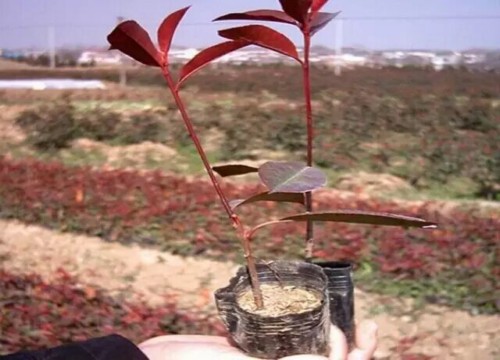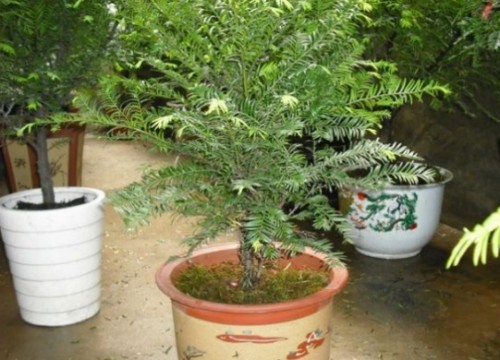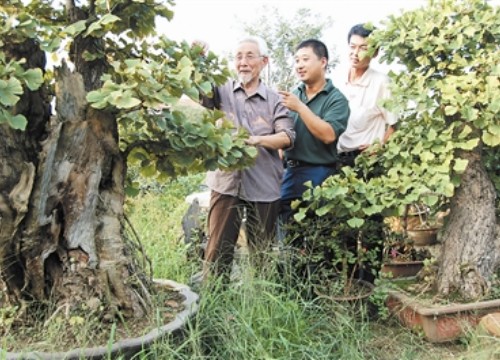Techniques of seedling raising of Pistacia chinensis potted plant
In recent years, affected by market and seedling technology, the demand for Pistacia chinensis seedlings has been heating up. In order to do a good job in base construction and form a large-scale production and processing industry chain of Pistacia chinensis as soon as possible, the research and popularization of practical technologies such as seedling cultivation, low-yield forest transformation, pest control and so on have become practical problems in production. Aiming at the problems of high oil content, low success rate of seedling raising and treatment of epidermal wax layer of Pistacia chinensis seeds, a set of seedling raising techniques with simple and easy operation, saving manpower and material resources, high seedling emergence rate and remarkable effect were summarized in combination with practice.

1. Selection and treatment of nursery land
In order to reduce transportation and save nursery land, it is advocated to "turn seedlings around afforestation hills", that is, try to choose places close to afforestation sites, convenient transportation, flat terrain, water sources or irrigation conditions, and convenient management, and plant trees nearby and borrow soil nearby.
In the flat nursery, divide the seedbed and the footpath, the seedbed is generally 1.0~1.2 m wide, the bed length is unlimited, depending on the terrain, and the footpath width is 40 cm. Low beds should be used.
2. Selection of seedling container
Container material requirements light and cheap, ventilation, water permeability, stability and disassembly performance is good. Can use cylindrical bottomed plastic film container, diameter 13 cm, height 20 cm, film thickness of 0.02~0.06 mm, in the middle of the uniform hole 4~6 diameter 0.5 cm, to facilitate ventilation.
3. Preparation, disinfection and bagging of nutrient matrix
Nutrient matrix can be adapted to local conditions, local materials, the main components of the nutrient matrix can be conducive to water permeability, ventilation, water and fertilizer retention forest soil, turf soil, cultivation soil, raw loess, etc., appropriate with some vermiculite, pearlite, sawdust, bark powder, river sand, sawdust, etc., to ensure the growth of seedlings root system, respiration and absorption of nutrients, water, light weight matrix can also facilitate seedling and afforestation transportation. In large-scale popularization and application, topsoil of tillage layer is mainly used, and certain decomposed manure, compost, calcium superphosphate, potassium sulfate, urea and other chemical fertilizers are added. Select general soil, must be disinfected (with 0.5% potassium permanganate solution, spraying 5 kg per 100 kg of nutrient soil), in order to reduce soil miscellaneous bacteria infection, and according to the soil conditions, with pesticides.
The ingredients of the nutrient matrix should be mixed evenly, dry and wet should be moderate, and it is better to hold hands without sticking hands and soil into groups. Sift the soil before bagging to ensure it is finely divided. The nutrient matrix of the filling container shall be compacted, and the leakage shall not be caused by hand lifting and the collapse shall not be caused by watering. The nutrient medium should be filled at 2 cm along the edge of the container to facilitate seeding and watering. After the bags are filled, they are arranged neatly along the seedbed, and the gaps between the bags are filled with fine soil, otherwise the emergence, growth and management of seedlings will be affected.
The following describes seedling management methods and precautions.
Cover removal: When the seedling amount reaches more than 50%, the film can be gradually removed or the grass can be removed depending on the temperature. Continuous sunny days at high temperatures, can be covered with variable distance from the wind, anti-burn seedlings; most of the seedlings, gradually all the film will be broken; when the seedlings fully exercise, emergence neat, the film or cover grass removed.
Thinning: thinning out excess seedlings one week after full emergence. One or two plants can be kept in each container. The lack of plants in a timely manner to fill the container seedlings, seedlings and fill seedlings after timely watering.
Topdressing: When the seedling height is 15 cm, topdressing begins. Foliar spraying is adopted, with 0.2%~0.5% urea aqueous solution, spraying 2~3 times in fast-growing period. Topdressing should be carried out in the evening, avoid high temperature fertilization at noon.
Watering: Watering should be timely and appropriate, watering thoroughly immediately after sowing or transplantation, watering frequently in the emergence period and seedling growth period, keeping the culture substrate moist; watering in the fast-growing period for many times, watering after the substrate reaches a certain degree of dryness.
Weeding: master the principle of "early, small and except", so that there are no weeds in the nursery, and manual weeding should be uprooted when the substrate is wet, so as to prevent loose seedling roots.
Whole bed: found in the seedling period of the container substrate sinking, must be filled in time to prevent root exposure. Timely pest control.
Prevention of sunburn damage: mainly manifested as the root neck of seedlings decayed after emergence, spray water to cool down, spray water to cool down in time before the ground temperature rises at noon in sunny days; shade treatment, shade shed or shade net can be used.
Seedling transportation: watering once a week before seedling afforestation can not only increase the moisture of the soil in the plastic film container, but also maintain the compactness of the soil in the plastic film container without loosening. Do not squeeze during seedling raising and transportation to ensure that the nutrient soil mass is intact. Cut the roots outside the container.
Time: 2019-06-12 Click:
- Prev

Modeling skills of Coptis chinensis bonsai
Pistacia chinensis wood is hard and fine-grained, which can be used for construction, agricultural tools, furniture and carving. The crown is tall and perfect, the leaf shape is slender and soft, the leaves are bright red after autumn, and the fruit is blue and red alternately. It can also be used as an ornamental and greening tree species in the city. Its tender leaves can be used to make tea, and its bark and stem can be used as medicine.
- Next

Modeling skills of Ginkgo biloba bonsai
Choose a suitable tile basin, fill it with thick and fine soil, and plant the piles in the basin between February and March. During the growth period, the branches are bent or straight, oblique or positive, or leaning or leaning, so as to control the direction and orientation of the extension. The prototype is the basis for making bonsai. Processing prototype
Related
- Fuxing push coffee new agricultural production and marketing class: lack of small-scale processing plants
- Jujube rice field leisure farm deep ploughing Yilan for five years to create a space for organic food and play
- Nongyu Farm-A trial of organic papaya for brave women with advanced technology
- Four points for attention in the prevention and control of diseases and insect pests of edible fungi
- How to add nutrient solution to Edible Fungi
- Is there any good way to control edible fungus mites?
- Open Inoculation Technology of Edible Fungi
- Is there any clever way to use fertilizer for edible fungus in winter?
- What agents are used to kill the pathogens of edible fungi in the mushroom shed?
- Rapid drying of Edible Fungi

